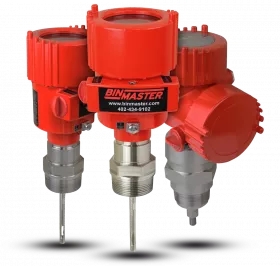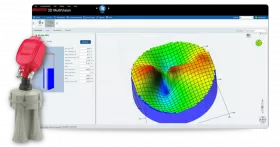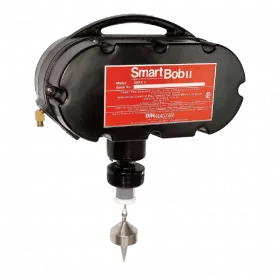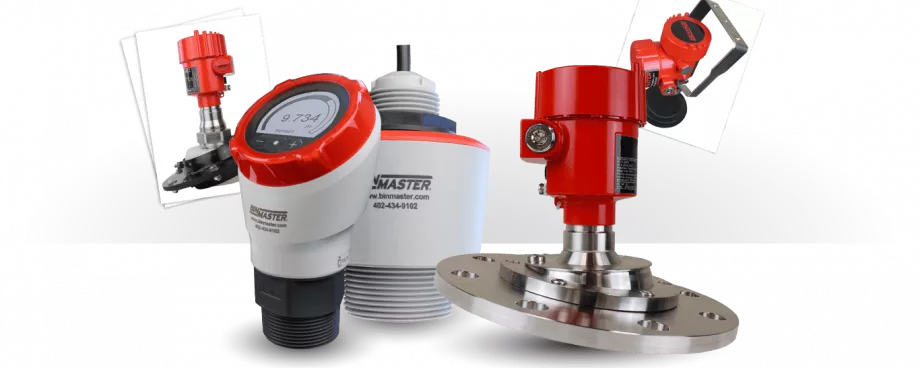
Some applications of level measurement include food processing, resin silos, grain storage, cement and aggregate processing, and chemical manufacturing. Accurate level measurement helps ensure product quality such as in the case of food or cement manufacturing where batch control is critical. For grain storage, preventing overfilling of bins and proper filling of railcars or barges is important to ensure the correct amount of product is shipped. For most industries operating costs and shrinkage are reduced by purchasing and using the right amount of raw materials.
For process and inventory control the more commonly used types of industrial level sensors are continuous measurement sensors. The physical properties of the substance being stored or processed, and the desired accuracy determine the type of level sensor to be used.
Level monitors employee different operating principles, each coming with different considerations such as costs, suitability, accuracy, and challenges associated with different materials based upon their flowability, granularity, and weight.
Open Air Radar
Since the advent of 80 GHz radar, this technology has been widely accepted for use in both solids and liquids due to its high reliability, accuracy, and fast update rate. An open‐air radar sensor transmits a radio‐frequency signal to the material surface, which reflects a small portion of the signal back to the sensor’s antenna. The sensor processes this returned signal to determine the material’s level.
An 80 GHz radar measures in a very focused 4° beam angle that is ideal for precise targeting in any vessel type, including those with internal structure. Open‐air radar sensors measure the material level at a single point where the sensor is aimed. They are unaffected by process temperature, pressure, or bulk material density.
3D Scanners
Acoustics-based technology used in 3D scanners is different as these devices scan the material surface to take multiple measurements. Level detection accounts for high and low spots in the silo. Scanning the surface also detects conditions such as cone up or cone down as well as sidewall buildup. The data from multiple measuring points is processed using advanced firmware and algorithms, and when combined with the silo’s parameters loaded into the software, provides a highly accurate volume estimate.

A scanner offers unique 3D imagery of the contents of the vessel. Multiple 3D scanners can be used in a large diameter vessel to account for irregular piling when reporting inventory. Users report the benefits of reducing inventory carrying costs and safety stocks. 3D visualization detects sidewall loading that could damage vessel structure.
Plumb Bob

This mechanical instrument uses a weight‐and‐cable to work like an automatic measuring tape: The sensor lowers a cable with a weight (also called a bob or probe) attached to its end into the vessel. The sensor determines the material’s level by measuring how much cable has been let out when the weight reaches the material’s surface; then the sensor retracts the cable and returns the weight to the vessel’s top.
The weight‐and‐cable sensor is programmed to take measurements at predetermined intervals, such as every 30 minutes, once an hour, every 6 or 8 hours, or once a day. This sensor is highly reliable, reasonably priced, and has a long service life.
Guided-Wave Radar
This sensor uses time‐domain reflectometry to measure the distance from the sensor to the material. For this sensing method, a low‐power microwave signal is sent along a sensing probe (a cable with a counterbalance weight at its end) that acts as a wave guide, concentrating the radar signal within a small diameter around the probe. The sensor calculates the material level based on the signal’s flight time. The sensor’s cable diameter and length vary depending on the material’s characteristics and the vessel size.
Guided‐wave radar sensor typically used in vessels under 100 feet tall and can be used in powders, granules, pellets, and other bulk solids. It can be used in many low dielectric materials, in high dust or humidity, and is immune to condensation.
Inventory Reporting
Analog, Modbus, or HART sensors can interface with cloud-based inventory software or with PLCs. Advancements in user-interface technology makes these services easy to set up and expand as needed. Subscription services are generally charged per sensor or per vessel and based upon the number of daily readings or data usage.
■

